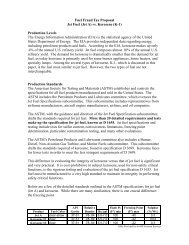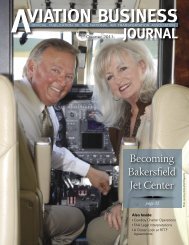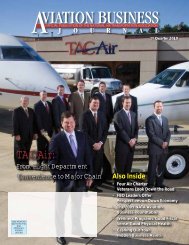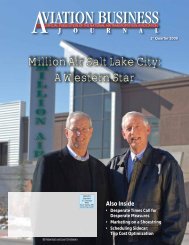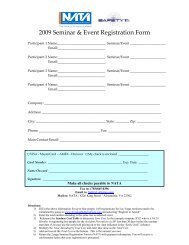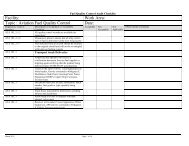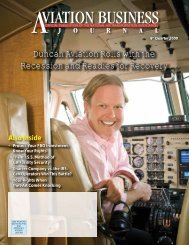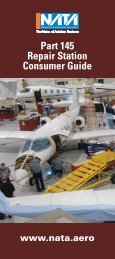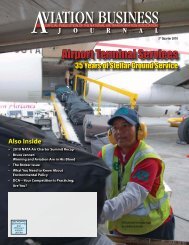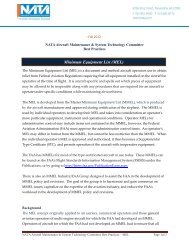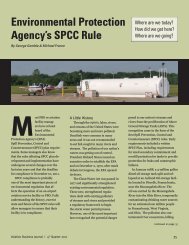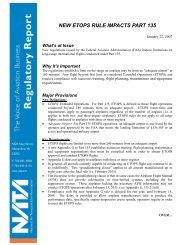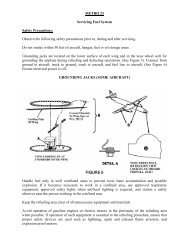Bridgeford Flying Services: A Vintage Napa Valley FBO You ... - NATA
Bridgeford Flying Services: A Vintage Napa Valley FBO You ... - NATA
Bridgeford Flying Services: A Vintage Napa Valley FBO You ... - NATA
Create successful ePaper yourself
Turn your PDF publications into a flip-book with our unique Google optimized e-Paper software.
President’s Message<br />
Continued from page 7<br />
make a sale. Aircraft charter prices, for example, in<br />
some markets are so obviously below costs that it<br />
reminds me of those 70 percent-off plane ticket fire<br />
sales that appear just before every airline bankruptcy<br />
announcement. In addition, airlines are notoriously<br />
slow in reducing surplus capacity, in part<br />
because the bankruptcy laws allow weak airlines<br />
to survive long after they’ve failed in the marketplace.<br />
Weak minimum standards affect our industry<br />
the same way. We need to make sure that airports<br />
aren’t urging too many <strong>FBO</strong>s to put out a shingle<br />
when the local market isn’t big enough to support<br />
them all.<br />
Perhaps the airlines’ most obvious waste of time<br />
and money has been their User Fee campaign in<br />
Washington. Millions of dollars were spent on inane<br />
TV ads, while high-priced airline lobbyists wasted<br />
valuable face time with top politicians on an issue<br />
that, in retrospect, was the least of their worries.<br />
And as the User Fee battle raged over the past four<br />
years, the airlines lost allies left and right, from<br />
ATC controllers to big corporations (with flight<br />
departments) that bought millions of airline tickets<br />
but also wanted to fly private aircraft without<br />
airline-dictated new user fees.<br />
But as we watch airlines struggling to survive, the<br />
central question (for them and us) is how to control<br />
costs in a crisis. For the airlines, that means primarily<br />
fuel and labor. Labor costs, including salaries,<br />
benefits, and pensions, were unfettered for decades<br />
as airline executives and complicit accounting standards<br />
allowed the real price tag of union contracts<br />
to be hidden in footnotes on income statements,<br />
inflating airline profits (as well as the stock pricelinked<br />
option packages) and disguising what would<br />
eventually prove to be fatal liabilities. Bankruptcy<br />
let airlines nullify labor agreements, but their workers<br />
blamed only management and ever since the<br />
“friendly” labor skies have disappeared. Both sides,<br />
perhaps, should blame the accountants—or the<br />
regulations that permitted such chicanery.<br />
The Challenge of Fuel Pricing<br />
Fuel costs, for the airlines and for everyone else,<br />
are far more problematic. The challenge here,<br />
other than reducing fuel use, waste, and cost, is to<br />
raise prices in step with rising costs without losing<br />
customers. Every <strong>NATA</strong> member faces the same<br />
challenge, and some will surely repeat the mistakes<br />
of the airlines. The winners will learn to stay ahead<br />
of the pack, investing in the latest price data, using<br />
it wisely, and adjusting prices and margins to<br />
optimize net revenue. There is, for every product<br />
or service, a price point that produces optimum<br />
revenue. Like trying to find the perfect mixture of<br />
air and gas for peak power in an airplane, it takes<br />
a wise and experienced pilot (or a good computer)<br />
to pick the right number. The airlines, individually<br />
I suspect, know how to raise prices to offset fuel<br />
costs. But as an industry, they have failed to keep<br />
themselves profitable. In the long run, that can<br />
only be fatal.<br />
Keeping your company healthy in this dynamic<br />
aviation economy means learning these five airline<br />
lessons and more. So, the next time you’re stuck<br />
in ORD or DFW waiting for your flight to arrive or<br />
fuming in a crowded plane stranded on the tarmac<br />
because there isn’t an open gate, take a moment<br />
to consider the joys of running an airline and then<br />
thank them for all that they’ve taught us. They may<br />
have lost billions of dollars, but what you and I can<br />
learn from them—that’s priceless!<br />
8 Aviation Business Journal | 2 nd Quarter 2008



